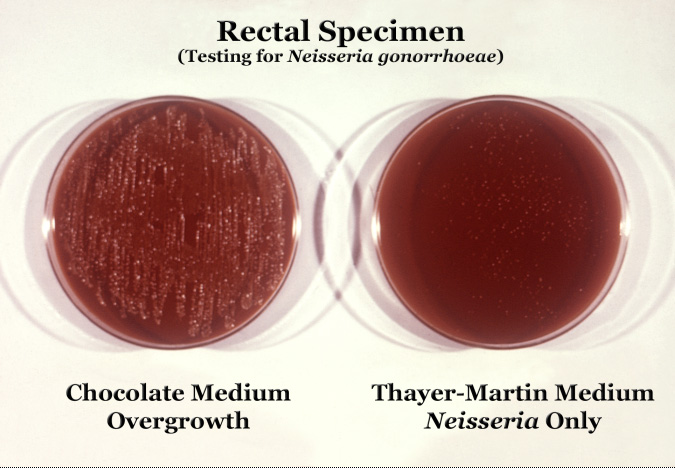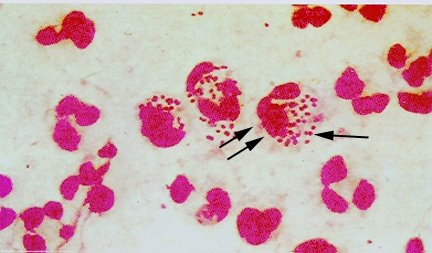Neisseria gonorrhoeae: Difference between revisions
| Line 48: | Line 48: | ||
:*Management of Sex Partners | :*Management of Sex Partners | ||
Recent sex partners (i.e., persons having sexual contact with the infected patient within the 60 days preceding onset of symptoms or gonorrhea diagnosis) should be referred for evaluation, testing, and presumptive dual treatment. If the patient’s last potential sexual exposure was >60 days before onset of symptoms or diagnosis, the most recent sex partner should be treated. To avoid reinfection, sex partners should be instructed to abstain from unprotected sexual intercourse for 7 days after they and their sexual partner(s) have completed treatment and after resolution of symptoms, if present. | :::* Preferred regimen:[[Cefixime]] PO 400 mg in single dose {{and}} [[Azithromycin]] PO 1 g in single dose | ||
::*Note: Recent sex partners (i.e., persons having sexual contact with the infected patient within the 60 days preceding onset of symptoms or gonorrhea diagnosis) should be referred for evaluation, testing, and presumptive dual treatment. If the patient’s last potential sexual exposure was >60 days before onset of symptoms or diagnosis, the most recent sex partner should be treated. To avoid reinfection, sex partners should be instructed to abstain from unprotected sexual intercourse for 7 days after they and their sexual partner(s) have completed treatment and after resolution of symptoms, if present. | |||
Pregnant women | :*Pregnant women | ||
:::* Preferred regimen:[[Ceftriaxone]] 250 mg IM in a single dose {{and}} [[Azithromycin]] 1 g PO in a single dose | |||
:*HIV Infection | |||
::*Persons who have gonorrhea and HIV infection should receive the same treatment regimen as those who are HIV negative. | |||
:*Suspected Cephalosporin Treatment Failure | |||
:::* Preferred regimen:[[Ceftriaxone]] 250 mg IM in a single dose {{and}} [[Azithromycin]] 1 g PO in a single dose | |||
:::*Treatment failure again | |||
:::* Preferred regimen:single doses of PO [[Gemifloxacin]] PO 320 mg single dose {{and}}[[Azithromycin]] PO 2 g single dose{{or}}[[Gentamicin]] 240 mg IM single dose {{and}}[[Azithromycin]] 2 g PO single dose | |||
::*Alternative regimen ceftriaxone 250 mg as a single IM dose and azithromycin 2 g orally as a single dose. | |||
Revision as of 17:25, 26 June 2015
| Neisseria gonorrhoeae | ||||||||||||||
|---|---|---|---|---|---|---|---|---|---|---|---|---|---|---|
 Neisseria gonorrhoeae cultured on two different media types.
| ||||||||||||||
| Scientific classification | ||||||||||||||
| ||||||||||||||
| Binomial name | ||||||||||||||
| Neisseria gonorrhoeae Zopf, 1885 |
Editor-In-Chief: C. Michael Gibson, M.S., M.D. [1]
Overview
Neisseria gonorrhoeae (also known as Gonococci) is a species of Gram-negative bacteria responsible for the sexually transmitted disease gonorrhoea.[1] Neisseria are highly fastidious cocci, requiring nutrient supplementation to survive. Thus, they grow on Chocolate agar (heated blood agar) with carbon dioxide. These cocci are facultatively intracellular and typically appear in pairs (diplococci).
Gonorrhoea symptoms include a purulent (or pus-like) discharge from the genitals which may be foul smelling, a burning sensation during urination and conjunctivitis commonly in neonates; that's why silver nitrate is used as a preventive measure. It also occurs occasionally in adults. Neisseria is usually isolated on a Thayer-Martin agar — an agar plate with 3 different antibiotics and nutrients which not only facilitate the growth of Neisseria species, but inhibit the growth of Gram-positive organisms and most bacilli and fungi. Further testing to differentiate the species includes testing for oxidase (all Neisseria show a positive reaction) and the carbohydrates maltose, sucrose, and glucose test in which N. gonorrhoeae will only oxidize (that is, utilize) the glucose.
If N. gonorrhoeae is resistant to the penicillin family of antibiotics, then ceftriaxone (a third-generation cephalosporin) is often used.
Patients should also be tested for Chlamydia infections, since co-infection is frequent.
Diagnosis
Pathology

Treatment
- Gonococcal Infections [3]
- Gonococcal Infections in Adolescents and Adults
- Uncomplicated Gonococcal Infections of the Cervix, Urethra, and Rectum
- Preferred regimen : Ceftriaxone 250 mg IM in a single dose AND Azithromycin 1g PO in a single dose
- Alternative regimen:Cefixime 400 mg PO single dose AND Azithromycin 1 g PO single dose.(If ceftriaxone is not available)
- Uncomplicated Gonococcal Infections of the Pharynx
- Preferred regimen:Ceftriaxone 250 mg IM in a single dose AND Azithromycin 1 g PO in a single dose
- Gonococcal Conjunctivitis
- Preferred regimen :Ceftriaxone 250 mg IM in a single dose AND Azithromycin 1 g PO in a single dose
- Management of Sex Partners
- Preferred regimen:Cefixime PO 400 mg in single dose AND Azithromycin PO 1 g in single dose
::*Note: Recent sex partners (i.e., persons having sexual contact with the infected patient within the 60 days preceding onset of symptoms or gonorrhea diagnosis) should be referred for evaluation, testing, and presumptive dual treatment. If the patient’s last potential sexual exposure was >60 days before onset of symptoms or diagnosis, the most recent sex partner should be treated. To avoid reinfection, sex partners should be instructed to abstain from unprotected sexual intercourse for 7 days after they and their sexual partner(s) have completed treatment and after resolution of symptoms, if present.
- Pregnant women
- Preferred regimen:Ceftriaxone 250 mg IM in a single dose AND Azithromycin 1 g PO in a single dose
- HIV Infection
- Persons who have gonorrhea and HIV infection should receive the same treatment regimen as those who are HIV negative.
- Suspected Cephalosporin Treatment Failure
- Preferred regimen:Ceftriaxone 250 mg IM in a single dose AND Azithromycin 1 g PO in a single dose
- Treatment failure again
- Preferred regimen:single doses of PO Gemifloxacin PO 320 mg single dose ANDAzithromycin PO 2 g single doseORGentamicin 240 mg IM single dose ANDAzithromycin 2 g PO single dose
- Alternative regimen ceftriaxone 250 mg as a single IM dose and azithromycin 2 g orally as a single dose.
:*Disseminated Gonococcal Infection
- Treatment of Arthritis and Arthritis-Dermatitis Syndrome
- Preferred regimen :Ceftriaxone 1 g IM/IV q24h for 7 daysAND Azithromycin 1 g PO in a single dose
- Alternative regimen :Cefotaxime 1 g IV q8h for 7 days OR Ceftizoxime 1 g IV q 8 h for 7 days AND Azithromycin 1 g PO in a single dose
- Treatment of Gonococcal Meningitis and Endocarditis
- Preferred regimen :Ceftriaxone 1-2 g IV q 12-24 h for 10-14 daysAND Azithromycin 1 g PO in a single dose
- Gonococcal Infections Among Neonates
- Preferred regimen :Erythromycin (0.5%) ophthalmic ointment in each eye in a single application at birth
- DGI and Gonococcal Scalp Abscesses in Neonates
- Preferred regimen :Ceftriaxone 25-50 mg/kg/day IM/IV qd for 7 days OR Cefotaxime 25 mg/kg IV /IM q12h for 7 days.
- Note: The duration of treatment is 10-14 days if meningitis is documented
- Treatment of Neonates Born to Mothers Who Have Gonococcal Infection in the Absence of Signs of Gonococcal Infection
- In the Absence of Signs of Gonococcal Infection
- Preferred regimen :Ceftriaxone 25-50 mg/kg/day IM/IV in a single dose, not to exceed 125 mg
- Gonococcal Infections Among Infants and Children
- Infants and Children Who Weigh ≤45 kg and Who Have Uncomplicated Gonococcal Vulvovaginitis, Cervicitis, Urethritis, Pharyngitis, or Proctitis
- Preferred regimen :Ceftriaxone 25-50 mg/kg/day IM/IV in a single dose, not to exceed 125 mg
- Children Who Weigh >45 kg and Who Have Uncomplicated Gonococcal Vulvovaginitis, Cervicitis, Urethritis, Pharyngitis, or Proctitis
- Preferred regimen : Ceftriaxone 250 mg IM in a single dose AND Azithromycin 1g PO in a single dose
- Alternative regimen:Cefixime 400 mg PO single dose AND Azithromycin 1 g PO single dose.(If ceftriaxone is not available)
- Children Who Weigh ≤45 kg and Who Have Bacteremia or Arthritis
- Preferred regimen :Ceftriaxone 50 mg/kg (maximum dose: 1 g) IM or IV q 24 h for 7 days
- Children Who Weigh >45 kg and Who Have Bacteremia or Arthritis
- Preferred regimen :Ceftriaxone 1 g IM /IV q 24 for 7 days
References
- ↑ Ryan KJ, Ray CG (editors) (2004). Sherris Medical Microbiology (4th ed. ed.). McGraw Hill. ISBN 0838585299.
- ↑ http://picasaweb.google.com/mcmumbi/USMLEIIImages
- ↑ "Chlamydial Infections".
de:Neisseria gonorrhoeae it:Neisseria gonorrhoeae hu:Neisseria gonorrhoeae nl:Neisseria gonorrhea no:Neisseria gonorrhoeae